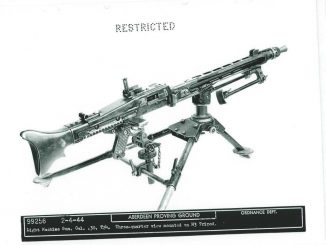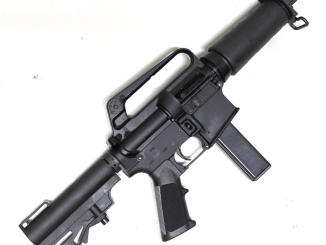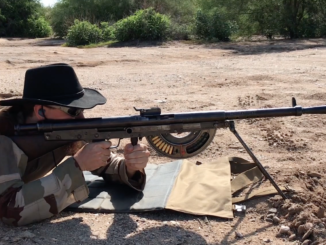Lot 152 (long rifle) and lot 1164 (carbine) in the RIA September 2020 Premier auction.
Henry Peabody was one of the less-recognized American firearms designers. A machinist from the age of 17, he worked at the Watertown Arsenal and eventually took a job as foreman for the Spencer rifle company in 1862. That same year he patented a dropping-block rifle action, and began working on developing it for military use. He partnered with the Providence Tool Company in Rhode Island to manufacture his guns, and while he was not able to get it adopted by the US military they did begin getting a number of foreign military contracts by 1867 or so. His big break was a sale of 15,000 guns to Switzerland in the aftermath of the Austro-Prussian War. This was followed by a contract for Spain, and then an open-ended sale to the French Government of National Defense in 1871 following the military disaster of the Franco-Prussian War. In total, some 113,000 Peabody sidehammer rifles and carbines were made over just a few years – a remarkable success for the time by a small company and otherwise unknown inventor.
Peabody and Providence Tool would follow this with an even more successful period manufacturing the Peabody-Martini rifle, but that is a story for another video. Henry Peabody died a wealthy bachelor in Boston in 1903, and left his fortune ($350,000 at the time; about $9 million by today’s value) to founding a girls’ school in Norwood Massachusetts.
For more details on the development of the Peabody rifles and the various contracts manufactured, I highly recommend Edward Hull’s book “Peabody Firearms”:




any idea how many peabody-martini’s were sold world wide? it must have been millions. i wouldn’t be too surprised to find that they are still being manufactured somewhere, especially in the smaller calibers. a wonderful rifle.
DAMKO is making a Martini-Henry replica.
Here is a video from Bloke on the Range featuring the Chap talking about and shooting the Swiss Peabody rifle. https://www.youtube.com/watch?v=_LEQ16x6h2E&feature=emb_title
More long windedness. Subjects like this and the accompanying stories and histories are what keeps me tuned into this channel.
Thanks for the book recommendation Ian. I just ordered a copy, it should be a nice companion to my hardly fired Canadian contract rifle.
Hnery O. Peabody’s School for Girls closed in 1989, but the profits from the Peabody Sidehammer and the Peabody-Martini continue to provide scholarships for women from Norwood, MA and the surrounding area:
http://hopscholarships.org/
Yes. The good old days. When shameless self promotion and
unbridled greed were viewed as weakness and not assets.
And in those good old days, it was also perfectly acceptable to install trapdoors of doom in the local bank, just in case of robbery. Nowadays the teller would get sued by the robber for injuries inflicted upon the latter when the trap was sprung.
Stephen, You’re talking about the Gilded Age – which gave us PT Barnum (self-promotion) and the “Robber Barons” (Greed)
“Peabody” is a coal company. Since Henry O. Peabody was from Boston instead of Chicago, his name is pronounced “pibbidy”. 😉
I’m sorry my son but yer too late in askin,Mr. Peabody’s coal train has hauled it away. RIP John Prine.
I might point out, however pedantically, that some of the Peabody rifles in the Spencer caliber were imported directly from Providence, RI to Cuba at the behest of Spaniards who volunteered to defend the “ever faithful isle” when the Cuban Ten Years War broke out while Spain proper was mired in civil conflict. At the time, the Spanish army was using a Berdan-designed ‘trapdoor’ breech to try to modify extant 1859 muzzle loading rifles while also casting about for a new breech loader. Since Civil War surplus was available to the insurrectos, the pro-colonial Spanish Voluntarios simply purchased rifles in the United States.
The Ejército Ultramar colonial army then followed up with additional purchases, while by 1871 the decision was made to adopt the Remington rolling block and begin producing it in Oviedo in Asturias too. The .43 Spanish cartridge is 11.15x58mmR, firing a 370-gr. .439 bullet backed by up to 70-77 grains of black powder. Very interesting to learn about the connection to the paper cartridge of the chassepot! I note that Ian said the Peabody used a .433 bullet with paper patch.
The Connecticut militia bought some of these too, which perhaps makes sense since RI is a fellow New England state and the transport costs would be minimal. These were also in .43 Spanish caliber.
My understanding is that some Scandinavian national armies were interested in the Peabody, but went with the rolling block instead.
Excellent overview.
And the rifle is good.
I wonder what is the reason for the presence of a striker instead of a hammer on an English order?
Only patent games, or were there practical considerations against the hammer?
As the owner and shooter of three Martini Henrys and two Martini cadets i think that the martini improved action is the fasest shoting single shot there is.
Gwyn
For one wiht the striker the action is faster as Stiven already said and the external hammer is like a remnant or relic of old times. Just like the “hammer” on a Remington-Keene rifle. Those external hammers were only there to comfort old habits, but had no real actual purpose and added an extra step to loading and firing. Removing the external hammer made the rifles simpler, sleeker and less prone to snag on brush or clothes or whatever. Also an external hammer can get bent or break off and make the rifle unuseable. You know what infantrists are like. Able to break an anvil. 😉
What happens if you don’t bring the hammer to half cock before opening the breech?
Unless it’s a rimfire you are going to eventually break off the firing pin nose. How do I know ? Wel I have a Pedersoli Sharps and have brocken the tip of three of the original one piece firing pins in the last 25 years. I have since converted to the ” new improved ” three piece firing pin, the large firingpin block, the actual firing pin tip and a small coil spring. I have about 400 45-70 cases doing the rounds and a good many have a drag line across the cartridbe head.
Gwyn
Reading you numbah one, Gwynn.
Many of those old irons require cocking before opening. Maybe that wasn’t quite as much of a handicap back in days of auld lang syne, when every shooter was raised from infancy with side-hammer locks.
But dammit all the same, why couldn’t those old gunsmiths design in 1) interlocks to prevent opening unless the hammer was half- or full-cocked? Peabody could have done it with a notch on the upper rear of his breechblock that the hammer nose dropped into on firing. That would prevent the breechblock from pivoting until the hammer was withdrawn.
Or 2) a self-cocking mechanism that drew the hammer back out of contact with the firing pin before the block opened enough to snag the pin’s nose? Rollin White’s self-cocking device on the original Sharps box-lock is a (probably too-clever) example (dunno what it was for in the absence of a firing pin, but anyway).
Before you tell me to invent my own, I already have. I envision an arm attached to the finger lever, extending out horizontally on the right side of the action far enough to clear the side of the receiver, and then turning up to sit in front of the hammer when it’s fully forward. As the shooter begins to work the finger lever, the arm swings backward, taking the hammer with it, initially just enough to allow the pin to withdraw behind the face of the breechblock, but continuing back as the lever moves forward until the hammer reaches full cock.
Yes, that would look like village blacksmith work, spoiling the lines of the gun and probably getting in the way at times; but it’s feasible, perhaps with a little tinkering with the lockwork to prevent stressing the arbor. Heck, some clever Sharps wrangler could try it as a wooden mockup, I bet. Wonder where we’d find one?
“you are going to eventually break off the firing pin nose”(С)
Thank You Gwyn.
This looks like a good reason.
Synchronizing the opening of the bolt with the preliminary swinging of the hammer is a rather non-trivial task. Requiring precise fit, which means quite costly.
In addition, this will significantly increase the force of opening the bolt, which means it will reduce the rate of fire.
And manual cocking of the hammer reduces the rate of fire by one and a half to two times.
In addition, these are “superfluous” details, which cannot but affect the reliability and service life of the sample.
Thanks for crushing my book budget, Ian!
The DAMCO Martini is based on Francotte action. You can see their type of cocking indicator standing proud on the right side of the breech block. This action was used in the Cadet rifles made by BSA mainly for the Australian schools cadet force.It was also produced by Wesley Richards for the Boer Republics during the 1880’s. It is much easier to clean than the regular Martini Henry as the whole action, including the block, can be removed as an unit by removing one screw
Really cool rifle.
Here’s a good site.
Perhaps it already happened, so be it.
http://www.martinihenry.org/index.php?route=information/information&information_id=7
http://www.martinihenry.org/index.php?route=product/product&path=61_59&product_id=78
http://www.martinihenry.org/index.php?route=product/product&path=61_67&product_id=139